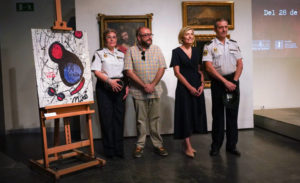Art forgery is one of the most lucrative criminal enterprises in Spain. The Spanish government takes the country’s national heritage and culture very seriously, so reports of police seizing forgeries are far more frequent. This past April, I wrote about how the Historic Heritage division of Valencia’s regional police seized five paintings by Spanish Old Masters, which turned out to be some of the worst and laziest fakes I’ve ever seen. There have been more seizures since that story broke in April, but the most recent one occurred in Valencia again. Police have seized five paintings from separate owners, all forgeries with fake documents.
The five seized works consisted of two allegedly by Goya, one allegedly by Renoir, one allegedly by Joan Miró, and one allegedly by Vicente Juan Masip (also known as Juan de Juanes). These works had proper-looking but fake documents attesting to their authenticity and value. The owner of the Goya portrait stated they had purchased the painting in 1999 for around €230,000. The other Goya work, a battle scene from Spain’s struggle against Napoleon’s invasions, had valuation documents stating it would fetch between €1.5 million and €1.8 million at auction. Since 2014, Valencia‘s Historic Heritage unit has performed over 2,000 seizures, confiscating around 6,000 counterfeits and forgeries worth €376 million. They receive tips from cultural centers and perform random searches on art and antique dealers. However, the fakes themselves are somewhat sloppy. For instance, regarding the Renoir floral still-life, the head of the Historic Heritage division, Antonio López, remarked that “the pictorial quality is clearly inferior. Anyone who looks at other floral works by the painter could easily see that.” Furthermore, the Ecce Homo painting attributed to Masip, a copy of a genuine Masip painting kept at the Prado Museum, was executed on canvas mounted on board. Masip tended to paint directly on the panel.
Police stated it’s likely that the original forgers took advantage of the false documents and the buyers’ lack of art knowledge to convince them to buy. “They were sold as Picassos, but they were actually Pikachus,” said López. These forgery rings are likely used to launder money or finance other criminal organizations.

